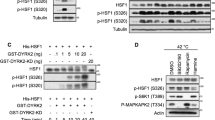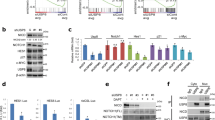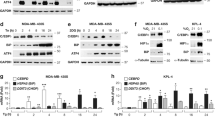Abstract
Expression of the Notch ligand JAG1 and Notch pathway activation promote poor prognosis, basal-like breast cancer. We have recently shown that the pseudokinase Tribbles homolog 3 (TRB3) regulates JAG1 expression in this malignancy. TRB3 is a stress and metabolic sensor, and here we show that nutrient deprivation or endoplasmic reticulum stress markedly upregulate TRB3, which serves as a scaffold for the deubiquitinase USP9x. USP9x in turn stimulates JAG1 activity through two mechanisms: (1) through TRB3 deubiquitination and stabilization, and (2) through deubiquitination and activation of Mind Bomb 1, an E3 ligase required for JAG1 ubiquitination-mediated endocytosis and Notch activation. These USP9x activities are confined to the signal-sending cell of a cell pair undergoing Notch signaling. We demonstrate that USP9x is required for TRB3 upregulation and Notch activation in response to cellular stress in basal-like breast cancer cells. These data suggest that TRB3 functions as a sensor of tumor microenvironmental stress and together with USP9x induces the cell survival and tumor-promoting activities of Notch. These findings identify a novel mechanism by which cancer cells survive in their hostile environment and provide potential therapeutic targets in breast cancer.
This is a preview of subscription content, access via your institution
Access options
Subscribe to this journal
Receive 50 print issues and online access
$259.00 per year
only $5.18 per issue
Buy this article
- Purchase on Springer Link
- Instant access to full article PDF
Prices may be subject to local taxes which are calculated during checkout







Similar content being viewed by others
References
Reedijk M, Odorcic S, Chang L, Zhang H, Miller N, McCready DR et al. High-level coexpression of JAG1 and NOTCH1 is observed in human breast cancer and is associated with poor overall survival. Cancer Res 2005; 65: 8530–8537.
Reedijk M, Pinnaduwage D, Dickson BC, Mulligan AM, Zhang H, Bull SB et al. JAG1 expression is associated with a basal phenotype and recurrence in lymph node-negative breast cancer. Breast Cancer Res Treat 2008; 111: 439–448.
Li D, Masiero M, Banham AH, Harris AL . The notch ligand JAGGED1 as a target for anti-tumor therapy. Front Oncol 2014; 4: 254.
Weinmaster G, Fischer JA . Notch ligand ubiquitylation: what is it good for? Dev Cell 2011; 21: 134–144.
Itoh M, Kim CH, Palardy G, Oda T, Jiang YJ, Maust D et al. Mind bomb is a ubiquitin ligase that is essential for efficient activation of Notch signaling by Delta. Dev Cell 2003; 4: 67–82.
Lai EC, Deblandre GA, Kintner C, Rubin GM . Drosophila neuralized is a ubiquitin ligase that promotes the internalization and degradation of delta. Dev Cell 2001; 1: 783–794.
Wang W, Struhl G . Drosophila Epsin mediates a select endocytic pathway that DSL ligands must enter to activate Notch. Development 2004; 131: 5367–5380.
Meloty-Kapella L, Shergill B, Kuon J, Botvinick E, Weinmaster G . Notch ligand endocytosis generates mechanical pulling force dependent on dynamin, epsins, and actin. Dev Cell 2012; 22: 1299–1312.
Nichols JT, Miyamoto A, Olsen SL, D'Souza B, Yao C, Weinmaster G . DSL ligand endocytosis physically dissociates Notch1 heterodimers before activating proteolysis can occur. J Cell Biol 2007; 176: 445–458.
Koo B-K, Lim H-S, Song R, Yoon M-J, Yoon K-J, Moon J-S et al. Mind bomb 1 is essential for generating functional Notch ligands to activate Notch. Development 2005; 132: 3459–3470.
Nagelkerke A, Bussink J, Mujcic H, Wouters BG, Lehmann S, Sweep FC et al. Hypoxia stimulates migration of breast cancer cells via the PERK/ATF4/LAMP3-arm of the unfolded protein response. Breast Cancer Res 2013; 15: R2.
Ohoka N, Yoshii S, Hattori T, Onozaki K, Hayashi H . TRB3, a novel ER stress-inducible gene, is induced via ATF4-CHOP pathway and is involved in cell death. EMBO J 2005; 24: 1243–1255.
Bowers AJ, Scully S, Boylan JF . SKIP3, a novel Drosophila tribbles ortholog, is overexpressed in human tumors and is regulated by hypoxia. Oncogene 2003; 22: 2823–2835.
Schwarzer R, Dames S, Tondera D, Klippel A, Kaufmann J . TRB3 is a PI 3-kinase dependent indicator for nutrient starvation. Cell Signal 2006; 18: 899–909.
Izrailit J, Berman HK, Datti A, Wrana JL, Reedijk M . High throughput kinase inhibitor screens reveal TRB3 and MAPK-ERK/TGFβ pathways as fundamental Notch regulators in breast cancer. Proc Natl Acad Sci USA 2013; 110: 1714–1719.
Lohan F, Keeshan K . The functionally diverse roles of tribbles. Biochem Soc Transact 2013; 41: 1096–1100.
Qi L, Heredia JE, Altarejos JY, Screaton R, Goebel N, Niessen S et al. TRB3 links the E3 ubiquitin ligase COP1 to lipid metabolism. Science 2006; 312: 1763–1766.
Taya S, Yamamoto T, Kanai-azuma M, Wood SA, Kaibuchi K . The deubiquitinating enzyme Fam interacts with and stabilizes beta -catenin. Genes Cells 1999; 4: 757–767.
Hua F, Mu R, Liu J, Xue J, Wang Z, Lin H et al. TRB3 interacts with SMAD3 promoting tumor cell migration and invasion. J Cell Sci 2011; 124 (Pt 19): 3235–3246.
Zhou Y, Li L, Liu Q, Xing G, Kuai X, Sun J et al. E3 ubiquitin ligase SIAH1 mediates ubiquitination and degradation of TRB3. Cell Signal 2008; 20: 942–948.
Nijman SM, Luna-Vargas MP, Velds A, Brummelkamp TR, Dirac AM, Sixma TK et al. A genomic and functional inventory of deubiquitinating enzymes. Cell 2005; 123: 773–786.
Murray RZ, Jolly LA, Wood SA . The FAM deubiquitylating enzyme localizes to multiple points of protein trafficking in epithelia, where it associates with E-cadherin and beta-catenin. Mol Biol Cell 2004; 15: 1591–1599.
Koritzinsky M, Levitin F, van den Beucken T, Rumantir RA, Harding NJ, Chu KC et al. Two phases of disulfide bond formation have differing requirements for oxygen. J Cell Biol 2013; 203: 615–627.
Hansson EM, Lanner F, Das D, Mutvei A, Marklund U, Ericson J et al. Control of Notch-ligand endocytosis by ligand-receptor interaction. J Cell Sci 2010; 123: 2931–2942.
Tseng L-C, Zhang C, Cheng C-M, Xu H, Hsu C-H, Jiang Y-J . New classes of mind bomb-interacting proteins identified from yeast two-hybrid screens. PLoS ONE 2014; 9: e93394–e93394.
Choe E-A, Liao L, Zhou J-Y, Cheng D, Duong DM, Jin P et al. Neuronal morphogenesis is regulated by the interplay between cyclin-dependent kinase 5 and the ubiquitin ligase mind bomb 1. J Neurosci 2007; 27: 9503–9512.
Overstreet E, Fitch E, Fischer JA . Fat facets and Liquid facets promote Delta endocytosis and Delta signaling in the signaling cells. Development 2004; 131: 5355–5366.
Mouchantaf R, Azakir BA, McPherson PS, Millard SM, Wood SA, Angers A . The ubiquitin ligase itch is auto-ubiquitylated in vivo and in vitro but is protected from degradation by interacting with the deubiquitylating enzyme FAM/USP9X. J Biol Chem 2006; 281: 38738–38747.
Parks AL, Klueg KM, Stout JR, Muskavitch MA . Ligand endocytosis drives receptor dissociation and activation in the Notch pathway. Development 2000; 127: 1373–1385.
Wennemers M, Bussink J, Scheijen B, Nagtegaal ID, van Laarhoven HW, Raleigh JA et al. Tribbles homolog 3 denotes a poor prognosis in breast cancer and is involved in hypoxia response. Breast Cancer Res 2011; 13: R82.
Irshad K, Mohapatra SK, Srivastava C, Garg H, Mishra S, Dikshit B et al. A combined gene signature of hypoxia and notch pathway in human glioblastoma and its prognostic relevance. PLoS ONE 2015; 10: e0118201.
Ackerman D, Simon MC . Hypoxia, lipids, and cancer: surviving the harsh tumor microenvironment. Trends Cell Biol 2014; 24: 472–478.
Du K, Ding J . Insulin regulates TRB3 and other stress-responsive gene expression through induction of C/EBPbeta. Mol Endocrinol 2009; 23: 475–485.
Ord D, Meerits K, Ord T . TRB3 protects cells against the growth inhibitory and cytotoxic effect of ATF4. Exp Cell Res 2007; 313: 3556–3567.
Salazar M, Carracedo A, Salanueva ÍJ, Hernández-Tiedra S, Lorente M, Egia A et al. Cannabinoid action induces autophagy-mediated cell death through stimulation of ER stress in human glioma cells. J Clin Invest 2009; 119: 1359–1372.
Vara D, Salazar M, Olea-Herrero N, Guzmán M, Velasco G, Díaz-Laviada I . Anti-tumoral action of cannabinoids on hepatocellular carcinoma: role of AMPK-dependent activation of autophagy. Cell Death Differ 2011; 18: 1099–1111.
Dobens LL, Bouyain S . Developmental roles of tribbles protein family members. Dev Dyn 2012; 241: 1239–1248.
Ohoka N, Sakai S, Onozaki K, Nakanishi M, Hayashi H . Anaphase-promoting complex/cyclosome-cdh1 mediates the ubiquitination and degradation of TRB3. Biochem Biophys Res Commun 2010; 392: 289–294.
Zhou M, Wang T, Lai H, Zhao X, Yu Q, Zhou J et al. Targeting of the deubiquitinase USP9X attenuates B-cell acute lymphoblastic leukemia cell survival and overcomes glucocorticoid resistance. Biochem Biophys Res Commun 2015; 459: 333–339.
Harris DR, Mims A, Bunz F . Genetic disruption of USP9X sensitizes colorectal cancer cells to 5-fluorouracil. Cancer Biol Ther 2012; 13: 1319–1324.
Pal A, Donato NJ . Ubiquitin-specific proteases as therapeutic targets for the treatment of breast cancer. Breast Cancer Res 2014; 16: 461.
Wang Y, Liu Y, Yang B, Cao H, Yang CX, Ouyang W et al. Elevated expression of USP9X correlates with poor prognosis in human non-small cell lung cancer. J Thoracic Dis 2015; 7: 672–679.
Dupont S, Mamidi A, Cordenonsi M, Montagner M, Zacchigna L, Adorno M et al. FAM/USP9x, a deubiquitinating enzyme essential for TGFbeta signaling, controls Smad4 monoubiquitination. Cell 2009; 136: 123–135.
Xie Y, Avello M, Schirle M, McWhinnie E, Feng Y, Bric-Furlong E et al. Deubiquitinase FAM/USP9X interacts with the E3 ubiquitin ligase SMURF1 protein and protects it from ligase activity-dependent self-degradation. J Biol Chem 2013; 288: 2976–2985.
Ossipova O, Ezan J, Sokol SY . PAR-1 phosphorylates Mind Bomb to promote vertebrate neurogenesis. Dev Cell 2009; 17: 222–233.
Jin Y, Blue EK, Dixon S, Shao Z, Gallagher PJ . A death-associated protein kinase (DAPK)-interacting protein, DIP-1, is an E3 ubiquitin ligase that promotes tumor necrosis factor-induced apoptosis and regulates the cellular levels of DAPK. J Biol Chem 2002; 277: 46980–46986.
van den Heuvel S, Harlow E . Distinct roles for cyclin-dependent kinases in cell cycle control. Science 1993; 262: 2050–2054.
Kamitani T, Kito K, Nguyen HP, Yeh ETH . Characterization of NEDD8, a developmentally down-regulated ubiquitin-like protein. J Biol Chem 1997; 272: 28557–28562.
Li S, Wang L, Berman M, Kong YY, Dorf ME . Mapping a dynamic innate immunity protein interaction network regulating type i interferon production. Immunity 2011; 35: 426–440.
Tong J, Taylor P, Moran MF . Proteomic analysis of the epidermal growth factor receptor (EGFR) interactome and post-translational modifications associated with receptor endocytosis in response to EGF and stress. Mol Cell Proteomics 2014; 13: 1644–1658.
Acknowledgements
This study was supported by funds to MR from the Canadian Breast Cancer Foundation. This research was funded in part by the Ontario Ministry of Health and Long Term Care. The views expressed do not necessarily reflect those of the OMOHLTC. We thank J Tong for technical support, and B Martin and P Taylor for bioinformatic support.
Author information
Authors and Affiliations
Corresponding author
Ethics declarations
Competing interests
The authors declare no conflict of interest.
Additional information
Supplementary Information accompanies this paper on the Oncogene website
Supplementary information
Rights and permissions
About this article
Cite this article
Izrailit, J., Jaiswal, A., Zheng, W. et al. Cellular stress induces TRB3/USP9x-dependent Notch activation in cancer. Oncogene 36, 1048–1057 (2017). https://doi.org/10.1038/onc.2016.276
Received:
Revised:
Accepted:
Published:
Issue Date:
DOI: https://doi.org/10.1038/onc.2016.276
This article is cited by
-
Mitochondrial stress induces hepatic stellate cell activation in response to the ATF4/TRIB3 pathway stimulation
Journal of Gastroenterology (2023)
-
Laminin-integrin a6b4 interaction activates notch signaling to facilitate bladder cancer development
BMC Cancer (2022)
-
High VSX1 expression promotes the aggressiveness of clear cell renal cell carcinoma by transcriptionally regulating FKBP10
Journal of Translational Medicine (2022)
-
Tribbles homolog 3-mediated targeting the AKT/mTOR axis in mice with retinal degeneration
Cell Death & Disease (2021)
-
TRIB3 promotes MYC-associated lymphoma development through suppression of UBE3B-mediated MYC degradation
Nature Communications (2020)



